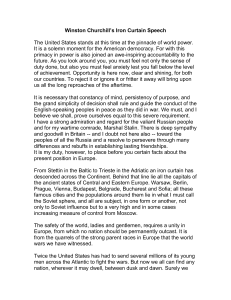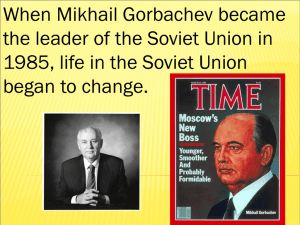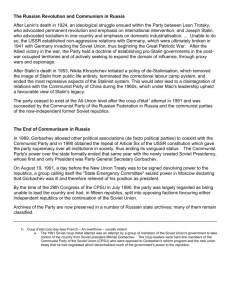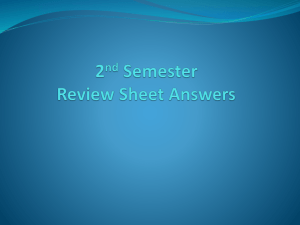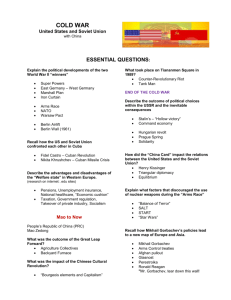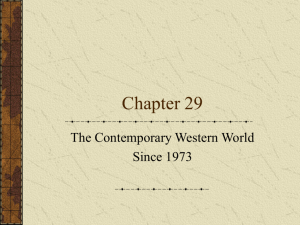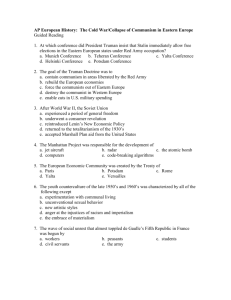Chapter 16: The Gorbachev Revolution
advertisement
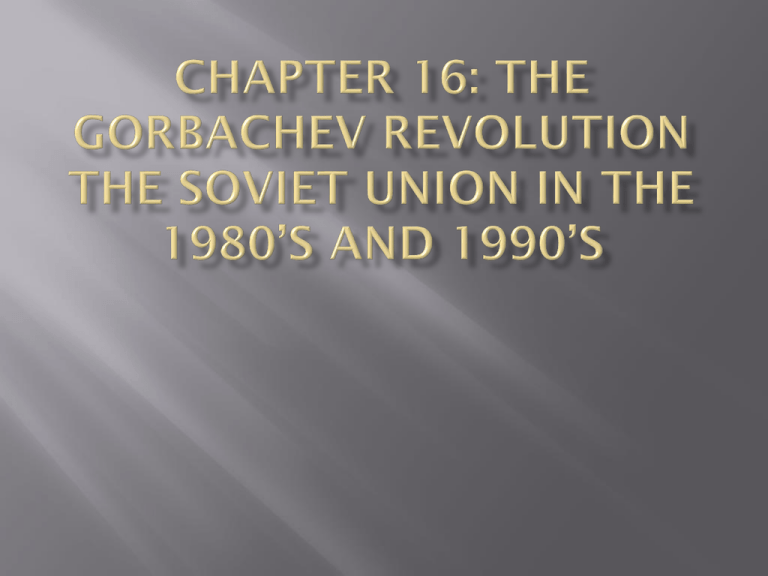
On March 11, 1985 The Politburo of the USSR approved Mikhail Gorbachev Gorbachev was influenced by Khrushchev’s speech to the 20th Party Congress and was interested in making significant changes to the structure of the USSR He had attracted the attention of the Communist Party by dealing with agricultural problems in Stavropol. He was moved to Moscow in 1978 where he became responsible for all of the USSR’s agriculture by the Central Committee of the Communist Party Gorbachev created the Regional Agricultural Industrial Organization (RAPO) in 1982 to reduce waste between the field and the processing plant. The RAPO was modelled on American companies and was made up of agribusiness units. The hope was that the industrialization of agriculture would solve the ongoing Soviet problem of food production Unfortunately by 1987 consumers were faced with even greater shortages Even though RAPO had failed to solve the agricultural problems of the USSR Gorbachev was still selected in 1985 by the Politburo of the Soviet Union to lead the nation Upon taking power in 1985 Gorbachev discovered just how bad the problems in the Soviet economy were. Initially Gorbachev embarked on a moderate program of reform He modernized the machine-tool industry Did some moderate reformation of the economy Encouraged innovation in science and technology He also replaced many of the older members of the Politburo, with younger people who had technical expertise Despite the reconstruction of the Politburo Gorbachev still faced criticism from both the extreme right and left of the Soviet factions The basis of Gorbachev’s reform program hinged on the adoption of a series of philosophies Glasnost- which meant transparency or openness, freedom of information and government transparency a policy that commits a government or organization to greater accountability, openness, discussion, and freer disclosure of information than previously, Perestroika- Which meant restructuring or economic reform in the USSR The stated objectives included decentralized control of industry and agriculture and some private ownership. Uskorenie- or acceleration would be applied to both of these concepts and this would be aided by Demokratizatsiya- Democratization. Which meant that he intended to put his country under the control of its citizens by allowing them to participate in their government or decision-making processes in a free and equal way Of all of the these concepts Perestroika became the most important as in involved the restructuring of both the political and economic systems. Perestroika could not work unless it was supported by democratization and openness to stop the bureaucratic abuses that had resulted in the economic problems the Soviets were experiencing Applying perestroika was difficult Gorbachev faced opposition for not decollectivizing agriculture as the Chinese had done (the Chinese system allowed farmers to send a quota of grain to the collective farm and keep any surplus for themselves, this had resulted in a big incentive for the Chinese farmers and created surplus goods for the open market reducing shortages and improving standards of living) The RAPO, however did not want to move to a collective farming model, then when the 6 ministries that had previously been in charge of dealing with agricultural issues in the USSR were consolidated into one they became unable to effectively delegate responsibility or direct production. During the winter of 1989-1990 it became difficult for residents of Moscow and other urban centers to access even the most basic food stuff. One of the key factors in the potential success of perestroika was the encouragement and reward of private economic initiative and development The Enterprise Law passed June 30, 1987 established the independence of small business operations (enterprises) from the state ministries or Gosplan These enterprises were self-sufficient and not subsidised by the state. Contracts would now be negotiated directly with individual customers This system was crippled by the stipulation that the state could order 50% to 70% of a companies production leaving little or nothing for private sale. Cooperative enterprises like those that produced luxury goods were also ultimately driven to fail due to detrimental state policy. Particularly within the Russian Republic people were resentful of those of a better economic status than the norm This is reflected by some government policies The Ministry of Finance imposed a tax on cooperatives that began at 30% but grew to 90%. Ultimately the Supreme Soviet (the two-chamber national legislature of the former Soviet Union) was forced to step in and reduced the tax to a maximum of 50% One of the biggest problems Gorbachev faced with his attempt to introduce aspects of a market economy was that there was a complete absence of a history of free enterprise within the culture of the Soviet Union. The USSR had moved from serfdom to Communism without a development of much of a middle or merchant class. The average Soviet citizen had no personal or family history of economic self determination Structural changes in the Soviet political system were essential for the success of Gorbachev’s planned reforms, however once members of the existing bureaucracy realized how that restructuring might affect them they began to openly resist Gorbachev’s reforms Surprisingly the first serious challenge to Gorbachev’s leadership came from Boris Yeltsin at the 1987 plenum of the Central Committee Yeltsin had been a supporter of Gorbachev, however he grew impatient with the pace of reform and the amount of power that the conservatives still held in government. In his speech to the Central Committee Yeltsin condemned the party and Gorbachev, suggesting that the existing Politburo was moving too slowly, promising too much and internally divided on the way in which reform should be instituted Yeltsin had the support of a large number of students and intellectuals, who were angry that Gorbachev had dismissed Yeltsin on the grounds that he was a “Stalinist” Gorbachev felt that Yeltsin was a revolutionary and that various stages of socialism must be ascended on a ladder of reform Conservative factions were encouraged by Yeltsin’s dismissal and became more vocal in their resistance to the reform movement In March of 1988, Conservative criticism of Gorbachev culminated in a letter published supposedly by a Leningrad chemistry teacher named Nina Andreeva (actually by a propagandists for the Central Committee) The letter was highly critical of Gorbachev’s reforms suggesting that with the de-Stalinization program and liberalization of the USSR Gorbachev had destabilized the Soviet Society. Central Committee secretary, Yegor Ligachev Publicly praised that letter directly challenging Gorbachev’s rule Nina Andreeva Gorbachev mounted a counter offensive in April beginning with a special Politburo meeting designed to confront Ligachev and his supporters he demanded an explanation for the attack on perestroika On April 5, Pravda published an article against Ligachev’s attack, promoting Gorbachev’s reforms In a later letter Pravda suggested that in attacking perestroika Ligachev was actually providing a defence of Stalin and an encouragement to return to his policies Pravda went on to say that it would be impossible for the USSR to turn away from reform now and that perestroika was essential for the renewal of Soviet society Ultimately the Ligachev incident was resolved in Gorbachev’s favour, however the resistance to his ideas that it represented remained Originally Glasnost was meant to be Gorbachev’s most innovative reforms, it promised to institute an openness that had been unknown in Soviet society in the past. Freedom of speech had been openly repressed under the Soviet system, criticism of the government was dealt with harshly. The Tsarist regime of the past was not known for a great deal of personal freedom and Glasnost was meant to be groundbreaking While greater freedom of expression and the press were allowed their remained limits These included state secrets, war propaganda and medical records Despite limitations, glasnost allowed a view of Soviet society previously unavailable to anyone The existence of crime, alcoholism and prostitution which had been denied under earlier regimes became common news for Soviet citizens People were now free to criticize medical care, government building projects and the war in Afghanistan Books that had been banned under previous regimes because they were deemed to be critical of Communism were released for sale to the public (Boris Pasternk’s Doctor Zhivago etc.) Soviet historians were permitted to deal with events that had been “revised” or ignored, for example the Katyn Forest massacre of Polish officers by the Soviet army during WWII which was originally blamed on the Nazi’s was acknowledged by the Soviet government as was the toll caused by starvation during Stalin’s reign of terror While Glasnost provided a level of freedom of expression that the Soviet population had previously been deprived of it also promoted discussions of ethnic concerns and historical disputes that had been firmly put down in the past and in the new spirit of openness began to once again percolate to the surface of the Soviet satellite states. Instability developed in a number of areas, notably in Armenia, Azerbaijan, Georgia, the Baltic states of Estonia, Latvia and Lithuania and the Soviet southwest (populated by Ukrainians, Belarusians and Moldavians) Originally the USSR was structured as a federal state, allowing its satellites to function semi-autonomously, thereby accommodating the wide variety of ethnicities and cultures In 1923 Lenin organized a strong centralized Communist party to maintain political control while non-Russian languages and cultures were allowed to develop That all changed when Stalin took over. Stalin promoted Russian culture and language to bring the nation together. Local cadres who had promoted local ethnic culture were purged After Stalin’s death the issue of national identity re-emerged as nonRussian nationalities were growing at a greater rate than the Russian nationality and were becoming more vocal. Non-Russian peoples saw Russification as a threat and started to make demands regarding language, religion, and immigration rights After the Helsinki Accord, national groups tried to push their grievances forward Gorbachev inherited these problems when he took office and the policy of Glasnost allowed a much greater level of freedom to criticize than had previously existed On June 28, the 19th Party Conference convened in Moscow Gorbachev used in as a platform to promote his program of reform and to institutionalize the philosophies of democratization and Glasnost Although perestroika focused on economics there was now a realization that economic reform required political reform Protest against Russification At the 19th Party Conference Gorbachev proposed restructuring the Soviet political system Cutting the Party apparatus by as much as 50% This would require a substantial reduction of personnel An elimination of departments that duplicated government services The removal of party functionaries from local economic units The Idea was it would get rid of unnecessary bureaucratic apparatus and allow free economic units to solve problems without the interference of the Gosplan It would also allow the central bureaucracy to focus on issues of national importance These changes in enacted would have radically altered the nature of the Soviet Union, however by late 1988 rising unrest threatened to topple his rule and proposed reforms There were many voices that called for the reformation of the Soviet system Well before Gorbachev took office there were voices for change from within the soviet system This included Andrei Sakharov, the father of the Russian Hydrogen Bomb Sakharov became primarily responsible for developing the Hydrogen bomb in 1953 ending US domination of as a nuclear power. Sakharov went on in the 1960’s to campaign for a nuclear test ban treaty and improved Soviet relations with the international community He spoke out against the civil rights abuses within the USSR and helped to found the Soviet Human Rights Committee He won the Nobel peace prize in 1975 (the first Soviet citizen to do so) After his criticism of the war in Afghanistan Sakharov was arrested and internally exiled to Gorky (a closed city) in 1980 While in Gorky he undertook hunger strikes until he obtained permission for his wife’s eye surgery in Italy His Wife, Yelena Bonner, was also a civil rights campaigner in the USSR Her father was killed and her mother arrested during Stalin’s “Great Purge” of 1937 During WWII Bonner served in the army (where her eyes were damaged) After the war she became a doctor and joined the Communist Party of the Soviet Union (CPSU) She became disillusioned with the USSR after the invasion of Czechoslovakia in 1968, she became a dissident She married Sakharov in 1971 and resigned from the CPSU a year later and began to lead the Soviet dissident movement with Sakharov In 1989 the countries of Eastern Europe began to break free from the Soviet Union First Poland and Hungary attempted to hold free elections and eliminate the one party system of the Communist regime This was followed by anti Communist movements in East Germany, Czechoslovakia, Bulgaria and Romania Unlike previous attempts to break away from Soviet domination Moscow put up little to no resistance to the movements Romania was the only country in Central Europe that experienced any significant violence during the collapse of Soviet domination (more on the massacre of dissident Romanians later) Clip from the award-winning documentary "The Second Russian Revolution" Poland was the first country to obtain release from the Communist Party. On April 5, 1989, Solidarity leaders signed an accord with the Polish government that provided for the legal status of Solidarity and granted free and open elections The accord also reinstated the upper house of parliament, which would have 100 freely elected members and would be able to veto legislation from the lower house (of the 460 seats in the lower house, 35% would be open to Solidarity candidates) The June 4, election was a massive defeat for the Communist party Solidarity candidates took 99 of the 100 seats in the upper house and all 161 seats they were allowed to run for in the lower house Even when running uncontested many Communist candidates did not obtain the 50% they needed to win in a seat in the lower house, many people just voted No to the official candidate listed and spoiled their ballots Wojciech Jaruzelski resigned as leader of the Polish Communist party on July 29, 1989 On August 19 1989 Jaruzelski (who was still president) designated the Solidarity official Tadeusz Mazowiecki as prime minister, the first non-Communist to hold the post in the post WWII world. The new government of Poland began to restructure the economy and look to the future Wojciech Jaruzelski resigned as leader of the Polish Communist party on July 29, 1989 On August 19 1989 Jaruzelski (who was still president) designated the Solidarity official Tadeusz Mazowiecki as prime minister, the first non-Communist to hold the post in the post WWII world. The new government of Poland began to restructure the economy and look to the future -- Wojciech Jaruzelski Tadeusz Mazowiecki -- Following the announcement that non-Communist political parties would be tolerated, the control of Communism over Hungary began to erode Hungary began to cut the barbed wire that sealed its boarder with Austria in early May of 1989 On June 16th Imre Nagy (one of the key figures in the Hungarian Revolution in 1956 and later executed by the Soviets) was honoured with a hero’s burial after a public ceremony in Budapest’s Hero Square New independent liberal political parties began to develop Communist popularity was in decline Imre Nagy -- Karoly Grosz (who succeeded Janos Kadar as the leader of Communist Hungary) was stripped of most of his authority The Communist party started to talk about changing it’s name to something more progressive sounding Lacking public support and facing a liberal movement that was increasingly sure of its success in the upcoming free elections of 1990 the Communist party of Hungary decided it was time for a change The Communist party of Hungary formally disbanded on October 7, 1989 and renamed itself the Hungarian Socialist party It promised to follow democratic procedures and to reform its program to meet the needs of a new Hungary Hungarian Socialist Party– Campaign Film Hungarian Socialist Party – Campaign film- Struck Karoly Grosz --- As the boarder between Austria and Hungary became more open many East Germans asked permission through the Hungarian embassy to make their way through Hungary to Austria and on to West Germany Over the course of the summer of 1989 about 6000 East Germans arrived in Vienna via Budapest escaping on the pretext of taking a vacation By September of 1989 the number of East Germans attempting to gain entry to West Germany through Hungary increased The East German government began to tighten travel restrictions to cut off the flow of people escaping to West Germany Escaping East Germans switched their destination to the embassy in Prague as Czechoslovakia was assessable to East Germans without East German travel documents By October 1989, Freedom Trains (not to be confused with those of the civil rights movement in the USA during the 50’s and 60’s) were transporting East Germans to Prague where they attempted to gain sanctuary at the West German embassy before going to West Germany As the number of people seeking refuge in the West increased so did international demands that the East Germans lift travel restrictions and bring about democratic reform Demonstrations in East Berlin, Leipzig and Dresden showed the growing discontent inside East Germany Eventually both internal and external pressure (partially from Hungary) convinced the East German government to let about 30 000 East Germans to emigrate The East German Communist party replaced the hard-line Erich Honecker with more moderate Egon Krez in October However the easing of travel restrictions and the replacement of the incumbent Communist leader did nothing to stop the flow of East Germans to the West On November 1989 approximately ½ a million people demonstrated in East Berlin, mocking the Communist Party and demanding democratic reform On November 7th 1989 the entire East German cabinet resigned and the Politburo announced a reorganization, not enough On November 9th 1989 the Berlin Wall was opened at midnight by East German boarder guards The Wall had stood since August 13th, 1961 as a symbol of Cold War oppression and ill will throughout that weekend East Berliners celebrated with West Berliners and for the first time since WWII reunification of the two German states seemed like a possibility Berlin Wall Falls At the same time as Berlin was unravelling Bulgaria was also experiencing changes In 1988 approximately 310 000 ethnic Turks fled Bulgaria for Turkey to escape forced assimilation In 1989 Bulgarian dissidents began to voice serious concern about environmental pollution and dissatisfaction with the government Like other Eastern Bloc countries Bulgaria had experienced economic difficulty, however until Todor Zhivkov resigned on November 10th 1989 few realized that the Communist regime in Bulgaria was weakening The new Communist party leader Petar Mladenov promised free elections in the spring of 1990 And after the new Union of Democratic Forces led a 50 000 strong demonstration in Sofia on December 10th he gave up absolute power over the government As a final show of reform the Communist Party threw out Zhivkov from the Party ranks Petar Mladenov Freedom would not be as easily achieved by the people of Czechoslovakia When 10 000 people staged a demonstration in Wenceslas Square (where Jan Palach, the student set himself on fire in protest in 1968 when Warsaw Pact troops ended the “Prague Spring”) to demand change, the demonstration was put down by police. Order was imposed by Communist party leader Milos Jakes Dissent still filled the country Vaclav Havel (a writer who was a poet and play-write and a long time critic of censorship and founding member of the dissident civil rights group Charter 77) became a symbol of opposition to the government. Vaclav Havel ---- On November 20th more than 200 000 people marched through the streets of Prague demanding fee elections and calling for a general strike By November 25th the Communist party had resigned their positions The crowd was addressed by Alexander Dubcek, (the same reform minded leader, who had been ousted by Warsaw Pact troops in 1968) who urged them to continue to “act in such a way as to bring the light back.” November 27th the entire Czechoslovakian work force walked off the job in a two hour general strike As the demonstrations in Czechoslovakia continued one dissident group solidified the others into a unified force, a group called Civic Forum developed Civic Forum was a mass movement determined to created political opposition to the ruling Communist party in Czechoslovakia On December 7th Ladislav Adamec resigned as Prime Minister and was replaced by Marian Calfa Negotiations between the Communist party and Civic Forum resulted in Gustav Husak’s resignation as President on December 10th 1989 On December 29th 1989 Vaclav Havel became Czechoslovakia’s new President Havel demanded that free parliamentary elections be held in the new year The office of premier was given to Alexander Dubcek who had been a leading figure in the Prague Spring of 1968 Romania had been led by Nicolae Ceausescu since 1956 Ceausescu was a hard line Stalinist who ran an oppressive and brutal dictatorship characterized by complete domination of the people On December 17th Anti-Government demonstrators took to the streets to protest the arrest of the Reverend Toekes who was ethically Hungarian and acted as a spokesperson million ethnic Hungarians that called Romania “home” Ceausescu’s troops met the demonstrators with tanks and opened fire on the crowd of men, women and children by the thousand (a mass grave with a reported body count of 4500 bodies has been attributed to this massacre) Nicolae Ceausescu ----- As time wore on it became more and more obvious that the Romanian people were no longer willing to allow their fear of Ceausescu and his “special” police forces stop them from seeking greater freedom On December 25th 1989 Nicolae Ceausescu and his wife Elena (almost, if not as bad, as he was) were seized in a coup and later executed by firing squad The people of Romania were faced with rebuilding a society that had been isolated from the rest of the world for years and who’s population had been denied the most basic freedoms and modern living standards It was a huge task for a country with no history of political pluralism (the existence of different political groups inside one country) Ion Iliescu became the new president of Romania after the election of May 20th 1990 During 1989 Gorbachev abandoned the Brezhnev Doctrine The Brezhnev Doctrine which would have demanded the use of ideological and military control on the revolutionary movements discussed in the previous slides that were taking place in Eastern Europe Instead Gorbachev encouraged reform and stood by while Communist parties throughout the Soviet Bloc lost their monopoly on power and the one party system of the Eastern Bloc dissolved Political pluralism and market economics and the free elections that Stalin had promised at the Yalta conference (February 4-11, 1945) finally happened in 1989 and 1990 in Eastern Europe The Warsaw Pact was dissolved March 31st 1991 Initially, in Czechoslovakia and East Germany non Communist governments gained power and in Hungary and Poland Non Communists also took power in both the government and the military Subsequently free elections in the re unified Germany resulted in the election of Helmut Kohl’s conservative coalition and in Poland the Communists were defeated and Lech Walesa (you should remember him from the Solidarity movement) was elected as the new Pr --- Lech Walesa Helmut Kohl --- Two primary factors threatened Eastern European reform in the 1990’s were economic and nationalistic The region’s economies had suffered during the Communist regime and required injections of capital as well as the will of the existing population, people also had to face inflation and rising unemployment as they moved toward a free market system In Poland people began to see ample consumer goods available for purchase for the first time in years, however few could afford to buy them During 1990 the Council for Mutual Economic Assistance (the Comecon) which had regulated trade in the Soviet Bloc, ceased to exist. Soviet subsidies of energy also ceased The Soviet Union began to demand that the Central European countries pay for Soviet oil with hard currency This became even more problematic because of the Gulf crisis in 1990 –1991, which meant there was a significant chance that Iraq would not pay back the $4 billion they owed to Eastern European countries This combined with the fact that the Eastern Bloc currencies could not be exchanged for Western currencies blocked the Eastern Bloc countries from gaining any real place on the world markets The idea of German reunification made both the Soviet Union and France very uncomfortable The Soviets did not want a reunified Germany as a NATO nation France did not want a reunified Germany to invade it again In February and again in July Helmut Kohl (chancellor of West Germany) met with` Gorbachev to discuss reunification This resulted in a reunified Germany as a sovereign state with membership in NATO In return Kohl pledged West German financial support in East German reconstruction in addition to an aid package to the Soviet Union Helmut Kohl July 1st 1990 The economic union of East and West Germany became a reality East German stores stocked Western goods which East Germans could buy with a East German ostmark at par with the deutschmark. There were of course some fears of inflation and unemployment as East German factories were thrown into competition with their West German equivalents On October 2nd 1990 East and West Germany were reunited politically Helmut Kohl won the leadership of the newly unified Germany and plans began to reinstate Berlin as the capital The transition from a centrally planned economy to a free market system was hard Unemployment rose dramatically in the eastern regions as industry attempted to become profitable Resentment among the West Germans rose as they were expected to make sacrifices in an attempt to assist the assimilation of the East Germans to a Westernized way of life Mikhail Gorbachev was awarded the Nobel Peace Prize in recognition for his role in rapprochement (the establishment or renewal of friendly relations between people or nations that were previously hostile or unsympathetic toward each other ) with the West on October 15th 1990 Things were not so sweet back home. Gorbachev faced Economic, nationalist and political challenges throughout 1990-91 that threatened to bring down the Soviet Union Economic reforms under the policy of perestroika failed to revive the Soviet economy Despite record crops, food shortages persisted Mikhail S. Gorbachev Summary- with Nobel Peace Prize (5:20) The harvest transportation and distribution systems remained deeply flawed, and as a result food rationing had to be enforced and an appeal to the West was made for food aid Gorbachev still refused to allow private property or conversion to the free market system. A five Hundred Day Plan proposed by his reformist economic advisor Stanislav Shatalin to convert the economy to capitalism over a 500 day period was rejected Instead a currency reform aimed at removing excess rubles from the system and reducing inflation was undertaken This measure further eroded confidence in the banking system and wrought havoc with the small private sector of business that was permitted Seperatist movements, resulting from nationalist forces, threatended the existence of the USSR as all 15 republics declared their sovereignty. Gorbachev was determined to retain central control in Moscow. In the state of Lithunia in January 1991, Gorbachev backed his determination with the Red Army. 13 people were killed as the army attacked Lithuanians supporting the independece movement. Gorbachev claimed no knowledge of the action, which begged the question of his honesty and/or his control over the Army. On February 9th 1991, Lithuanians voted 90% in favour of establishing a sovereign independent state, despite intimidation from from Moscow. Soviet troops vs unarmed Lithuanian civilians, Vilnius 1991. Initially viewe das a reformer, he consolidated his power during 1990 to give him more control than any leader since Stalin. Boris Yeltsin posed a serious challenge, he proposed the institution of private property and the adoption of a free market Reformists like Nikolai Rhzhkov and Alexander Yakolev, were driven out of power. The most surprising move was the resignation of Eduard Schevardnadze, the Soviet foreign minister Schevardnadze was credited with improved relations with the West. He warned that a dictatorship was on the horizon and wanted no part in it. Boris Yeltsin ------------------- (He is tight with Clinton... wonder why?) The Soviet Union was huge and ethnically very diverse, with historically the Russians being the largest ethnic nationality. Out of 290 million people 145 were classified as Great Russians. The remaining 145 million represented a diversity of different religious, social, cultural and ethnic groups, not all of whom wished to give up their individual cultures to be absorbed into a greater “Russified” Soviet state. Article 76 of the Soviet constitution identified the USSR as a union of sovereign republics. Each of the 15 republics maintained its own Communist party organization , hymn, flag, and capital, while political, and social control was held by Moscow. This extended to cultural control when the concept of Russification was instituted. This created conflicts between centralized and decentralized control of political and economic decision-making. The Soviet Union (and Imperial Russia before it) had been expanding from the time of Peter the Great (Late 1600’s) The Soviet Union continued with the Imperialist policy of attempting to teach these groups both the Russian language and encourage them to adopt Russian customs. Despite the Communist (and Tsarist) attempts to wipe out nationalism, old loyalties and ties to culture remained Also the mixing of different national groups in countries like Armenia and Azerbaijan caused its own problems Russification programs in countries like the Ukraine gave benefits to people who learned the Russian language and adopted Russian culture This (combined with the fact that all the best positions in the bureaucracy were filled by Russians) caused civil uprisings once freedom of the press and free assembly were permitted by Glasnost The Caucasus region (Armenia, Azerbaijan and Georgia) each state enjoyed a brief period of independence post the 1917 revolution and the borders established in 1923 did not adequately address pre-existing ethnic differences February 23rd, 1988 1 million Armenians protested in the capital of Yerevan demanding the return to Armenia of the Nagorno-Karabakh region of Azerbaijan, (this region had a majority group of Armenians and had long been a source of harsh ethnic conflict) As Armenia’s population is over 90% Christian while Azerbaijan's is more that 90% Muslim there were issues. December 4th 1988 troops put down a demonstration in Baku, Azerbaijan (killing 3 and injuring many others) Violent acts against the Armenian minority continued in 1989 particularly in the Azerbaijani cities of Sumgait and Baku Guerrilla warfare continued along the border of the Nagorno-Karabakh region Finally the Armenian National movement and the Azerbaijani Popular Front agreed to attend conciliatory talks in Latvia in January of 1990 In 1991 both territories declared independence. Constitutions were adopted in 1995 however, serious issues revolving around rule of law, free elections and human rights remain The dispute in the Nagorno-Karabakh region heated up again in 1992. There was open war between 1992- and 1994 (30 000 dead, almost 1 million Azeris mostly Muslim displaced) Armenian forces were left in control of the enclave and despite the ceasefire Russia brokered in 1994, violence has been ongoing. This thread is dedicated to the genocides "Azerbaijan" committed against Armenians in Sumgait, Kirovabad, Baku, Maragha and other forgotten villages and towns that it cleansed and bombed indiscriminately during the Artsakh liberation war, also known as the Nagorno-Karabakh conflict. April 9th 1989 a peaceful demonstration in Tbilisi (the capital of Georgia) is attacked by Soviet troops, killing 19 people and injuring many more. Poison gas is also used on the crowd as they knell in prayer The demonstration was led by intellectuals and the factory workers who wanted an independent Georgia. Georgia did not receive independence until the collapse of the Soviet Union in 1991. In 1992 Georgia adopted a constitutional and elected Eduard Shevardnadze as president (the critic of Gorbachev’s policies mentioned earlier) Unfortunately Georgia has suffered from corruption and a general breakdown of its economy despite $1 billion in US aid Between 1990 and 1993 civil war raged between Georgia and Abkhazia (located on the Black Sea) Abkhazia was supported by Russia. By 1992 Georgia was forced to withdraw, the Russians withdrew in exchange for the Georgians accepting Russian military bases inside Georgia. Abkhazia declared independence, however it remains unrecognized by the international community The US considers Georgia within its sphere of influence Georgia contains nuclear material left over from the cold war and may harbour Al Qaeda members. US oil investment approaches $20 billion Recently Russia has reasserted its interest in reacquiring Georgia. The Baltic States of Estonia, Latvia and Lithuania had enjoyed a period of sovereign independence during the inter-war years. In August of 1989, 2 million people formed a human chain stretching through the three capital cities of Tallinn, Riga, and Vilnius, in a symbolic protest of the Nazi-Soviet pact of 1939 which had cost them their freedom. Popular front movements gained momentum in the region and in December of 1989 Lithuanian president Landsbergis declared Lithuanian independent of the USSR Gorbachev sent in tanks and troops Human Chain Protest ------ The Soviet Union imposed an economic embargo and a blockade to stop goods from entering Lithuania from Poland Estonia and Latvia followed Lithuania’s lead and declared that the Soviet Union had taken them over through illegal means By mid-June Gorbachev conceded that negotiations should be held on the Baltic issue The collapse of the USSR allowed for a resolution of the Baltic issue Each of the three is now a parliamentary democracy with a free market system They are members of the UN, the WTO, NATO and the EU Sometimes called the “Jewel in the Russian crown” the Ukraine is both geographically important, agriculturally rich and economically necessary for the former Soviet Union to control A significant amount of the USSR’s agricultural land lay with in the borders of the Ukraine and its position on the Black Sea gave it access to trade routes It held a seat on the UN as a republic of the USSR along with Belorussia and Russia When the Ukrainians began to make serious moves toward independence in 1990 it was a bad sign for the Soviet Union Initially, there were hopes for the Ukraine to become a successful democratic state, however the government remained corrupt and involved in questionable activities (including dealing arms to the Iraqis, that purportedly detect Stealth aircraft, and activities that have led to the city of Kharkov being called the “watering hole” for arms traffickers across the globe) it would not be until the late 1990s’ that the Ukraine would achieve any level of economic or political stability and has still not become a member of the EU Ukraine’s declaration of independence in 1991 led to the exodus of the other republics and was followed by the dissolution of the Soviet Union April 26th, 1986, a nuclear accident at the Chernobyl power plant resulted in the destruction of one of 4 RBMK-type reactors (the type of nuclear reactor cooled by water and moderated by graphite) The accident occurred during a safety test, During the test(due to human error) Instability was created in the reactor and the operator attempted to correct the problem by overriding the control rods. No safety mechanism was in place because of the test, so when a huge surge of power occurred, the resulting explosion destroyed the top of the reactor core and started a fire which threatened the other three reactors. Firefighters attempted to put out the fire They succumbed to radiation, and died becoming the first, but not last of the Chernobyl victims. Ukraine marked the 21st anniversary of the deadly explosion at the Chernobyl nuclear power plant, the world’s worst nuclear disaster. The April 26, 1986 explosion at the Chernobyl nuclear power plant affected about 3.3 million Ukrainians The poisons radioactive cloud produced by Chernobyl spread across a huge area including but not limited to; The western regions of Ukraine Belorussia Russia Eastern Europe and some parts of Scandinavia Initially the Soviet Union did not even report the disaster The first report came from Sweden who had picked up above normal amounts of radioactivity in its regular air tests Questions were raised regarding the Soviet Union’s failure to report a nuclear disaster (it seemed like a fairly large failure in Glasnost) Questions still remain regarding the number of victims the disaster claimed and the true extent of the environmental damage done both to the Ukraine and to surrounding areas About 100 000 people were evacuated from the Chernobyl area ( the city of Pripyat, remains abandoned) it is estimated that close to 2 million people were affected by radiation. Of these close to 1 million still live in contaminated areas. Over another ¼ million should be relocated but have nowhere else to go. Birth defects and cancer rates are up The official Soviet death toll is 31, that is unlikely at best. Sheep as far as Scotland and reindeer herds in Scandinavia have registered high levels of radiation that has been attributed to Chernobyl. Boris on a tank

